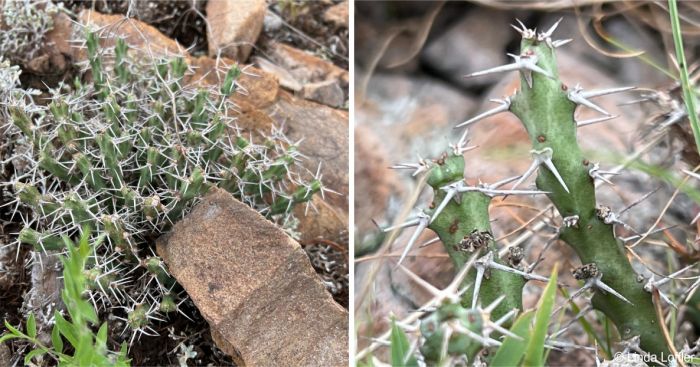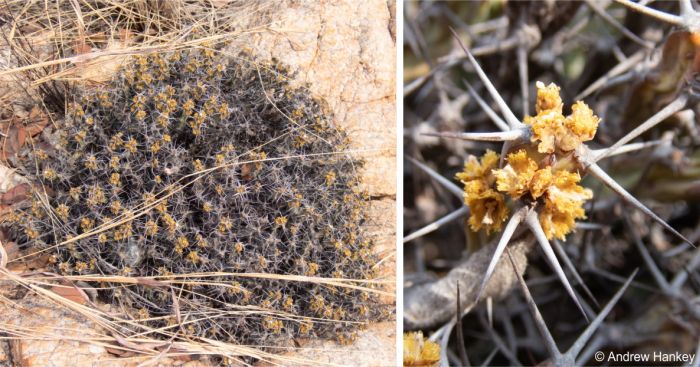Euphorbia schinzii
Euphorbia schinzii Pax
Family: Euphorbiaceae
Common names: rock-milkbush, northern noors, Schinz’s spurge (Eng.); klipmelkbossie (Afr.)
Introduction
Euphorbia schinzii is a small spiny plant with succulent stems, that enable it to store water, giving it resilience and allowing it to thrive in its harsh, arid habitat. It is indigenous to southern Africa, and belongs to the Euphorbiaceae, a family that encompasses a broad spectrum of plant taxa including spurges, poinsettias and the castor oil plant. Euphorbia schinzii is notable for its small stature and frequent occurrence amidst rocky landscapes and slopes. As is characteristic of numerous members within the Euphorbia genus, E. schinzii exhibits variable forms, with different individuals showing variations in growth habit and appearance.

Description
Description
Euphorbia schinzii typically is a small, low-growing, compact plant, 100–150 mm tall, forming compact clumps or mats. It has spiny, leafless, succulent stems that branch outwards, often creating a dense, bushy appearance. The stems are typically 4-angled, bluish-green to greyish-green, with paired, brown spines. The leaves are reduced to small, scale-like structures along the stems, rather than being prominently displayed, and soon fall off. The cyathium is cup-shaped, stalkless, bright yellow, with 5 broadly ovate fringed lobes enclosing the flowers. Three cyathia are clustered together, arranged alternately along the stems, towards the tips, from winter to spring (June to September). The fruit is a 3-lobed capsule.

Conservation Status
Status
Euphorbia schinzii is not threatened, it is assessed as Least Concern (LC) by the Red List of South African Plants.
Distribution and habitat
Distribution description
Euphorbia schinzii exhibits a wide distribution across various regions of South Africa, occurring in the provinces of North West, Gauteng, Limpopo, Mpumalanga, Free State and KwaZulu-Natal. Additionally, this species extends its range into the neighbouring countries Eswatini, Botswana, Mozambique and Zimbabwe, encompassing a significant portion of sub-Saharan Africa. It commonly inhabits rocky environments, preferring rocky slopes and outcrops with well-drained soil. Renowned for its resilience, E. schinzii thrives in the harsh environmental conditions characteristic of southern Africa's arid landscapes, attesting to its remarkable adaptability.

Derivation of name and historical aspects
History
The genus Euphorbia has a rich and diverse history. It has ancient roots, with its name derived from Euphorbus, a Greek physician to King Juba II of Numidia in the first century B.C. King Juba named the plant in honour of his physician, who first used its medicinal properties. The genus Euphorbia was formally described by the Swedish botanist Carl Linnaeus in his seminal work Species Plantarum in 1753. The genus encompassed a diverse morphology of botanical specimens since its inception, and has undergone refinement and expansion through continuous botanical research. Euphorbia is one of the largest and most varied genera of flowering plants, encompassing over 2 000 distinct species. These species exhibit remarkable diversity in morphology, habitat and ecological adaptations, ranging from succulent desert plants to herbaceous perennials and even trees. Widely distributed across the globe, Euphorbia species demonstrate a particular prevalence in tropical and subtropical zones, highlighting the genus’s global significance in botanical diversity and ecological adaptation.
This species is named after Dr. Hans Schinz (1858–1941) a Swiss botanist who was the Director of the Botanic Gardens and Botanical Museum of the University of Zurich and collected plants in Namibia from 1884 to 1887.

Ecology
Ecology
Euphorbia schinzii is adaptated for survival in arid ecosystems. Its succulent stems serve as reservoirs for water storage, enabling resilience during drought periods. Furthermore, the plant's small leaves minimize the surface area and mitigate water loss through transpiration. It reproduces through seed dissemination, facilitated by flowers tailored for insect pollination, notably by bees and flies. Following pollination, the fertilized flowers form small capsules containing seeds, which are dispersed by being forcibly expelled from the capsule when it bursts open. Characteristic of numerous members within the Euphorbiaceae family, E. schinzii harbours toxic compounds within its sap, acting as a deterrent against grazing and browsing animals. This chemical defense mechanism plays a pivotal role in safeguarding the plant from predation by herbivorous fauna. The hard and sharp spines that radiate out along the length the stems also protect the plants from grazers and browsers.

Uses
Use
Euphorbia schinzii serves as a popular choice for ornamental cultivation in gardens and is frequently grown as a rock-garden plant for landscaping purposes, or in containers. Additionally, traditional uses extend to medicinal applications, where the powdered form derived from dried roots is utilized as a galactagogue. This practice involves the application of the powder onto cuts on the breasts to stimulate lactation. Please note that the sap in the stems of euphorbias can be caustic and cause stinging or burning sensations when it touches the skin or the eye, and should be handled with care.
Growing Euphorbia schinzii
Grow
Euphorbia schinzii can be propagated through seeds or stem cuttings. To propagate from seeds, harvest mature seed capsules and sow them in well-draining soil. Maintaining consistent soil moisture until germination, typically occurring within a few weeks, is essential. Upon the emergence of seedlings, when several sets of true leaves have developed, they can be transplanted into individual pots. Propagation via stem cuttings involves taking a healthy stem segment with a sharp, sterilized knife, allowing it to form a callus by leaving it in a cool, dry place for a few days to prevent rotting, and planting it in a well-draining soil mix suitable for succulents. Soil should be kept lightly moist until roots develop, usually over a few weeks. Once roots are established, the cutting can be treated as a mature plant.
Euphorbia schinzii is well suited to warm, dry bushveld and grassland gardens and is ideal for rocky slopes. It needs well-drained loamy soil, plenty of well-rotted compost and moderate water in spring and summer and a dry winter without frost. Best in semi-shade. Also suitable for containers. Take care not to overwater.
When growing Euphorbia schinzii as a container plant indoors, it prefers a position in bright, indirect sunlight. Place it near a sunny window where it can receive several hours of sunlight per day. However, avoid intense, direct sunlight, as it can scorch the plant. This plant thrives in warm temperatures, and it needs to be protected from cold drafts and frost.
References
- Brown, N.E., Hutchinson, J. & Prain, D. 1925. Euphorbia. Flora Capensis 5(2).
- Deacon, A. 2023. Image of Euphorbia schinzii, Barberton, Mpumalanga. iNaturalist. Online. https://www.inaturalist.org/observations/194797320.
- Fabian, A. & Germishuizen, G. 1997. Wild flowers of northern South Africa. Fernwood Press, Vlaeberg.
- Hankey, A. 2022. Image of Euphorbia schinzii, Bojanala, North West. iNaturalist, Online. https://www.inaturalist.org/observations/138237687.
- Latti, I. & Kirkel. J. n.d. Euphorbia schinzii and bee. Operation Wildlfower. Online. https://www.operationwildflower.org.za/index.php/albums/euphorbias/euphorbia-schinzii-with-visiting-bee-judd-1-2284#joomimg.
- Loffler, L. 2023. Image of Euphorbia schinzii, Lubombo Region, Eswatini. iNaturalist, Online. https://www.inaturalist.org/observations/155709843.
- Oberlander, K. 2023. Image of Euphorbia schinzii, Pretoria North, Gauteng. iNaturalist, Online. https://www.inaturalist.org/observations/183053573.
- Pooley, E. 1998. A field guide to wild flowers Kwazulu-Natal and the eastern region. Natal Flora Publications Trust, Durban.
- Raimondo, D., Von Staden, L., Foden, W., Victor, J.E., Helme, N.A., Turner, R.C., Kamundi, D.A. & Manyama, P.A. (eds) 2009. Red list of South African plants. Strelitzia 25. South African National Biodiversity Institute, Pretoria.
- Useful Tropical Plants. Euporbia schinzii Pax Euphorbiaceae https://tropical.theferns.info/viewtropical.php?id=Euphorbia+schinzii. Accessed 16 March 2024.
- Vincentz, F. 2004. Image of Euphorbia schinzii. Wikimedia Commons. https://commons.wikimedia.org/wiki/File:Euphorbia_schinzii3_ies.jpg.
- Wikipedia. Euphorbia schinzii. https://en.wikipedia.org/wiki/Euphorbia_schinzii. Accessed 15 March 2024.
- Wikipedia. Euphorbia. https://en.wikipedia.org/wiki/Euphorbia. Accessed 16 March 2024.
Credits
Rofhiwa Ratshibvumo, SANBI Groen Sebenza Intern
and Aluwani Tshiila, Scientist Production – Botanist
Department of Economic Development, Environment, Conservation and Tourism (NWDEDECT)
April 2024
Acknowledgements: Images by Frank Vincentz, Andrew Hankey, Andrew Deacon, Kenneth Oberlander and Linda Loffler.
Plant Attributes:
Plant Type: Succulent
SA Distribution: Free State, Gauteng, KwaZulu-Natal, Limpopo, Mpumalanga, North West
Soil type: Sandy, Loam
Flowering season: Spring, Winter
PH: Acid, Neutral
Flower colour: Yellow
Aspect: Full Sun, Morning Sun (Semi Shade), Afternoon Sun (Semi Shade)
Gardening skill: Average
Special Features:
Horticultural zones









Rate this article
Article well written and informative
Rate this plant
Is this an interesting plant?
Login to add your Comment
Back to topNot registered yet? Click here to register.